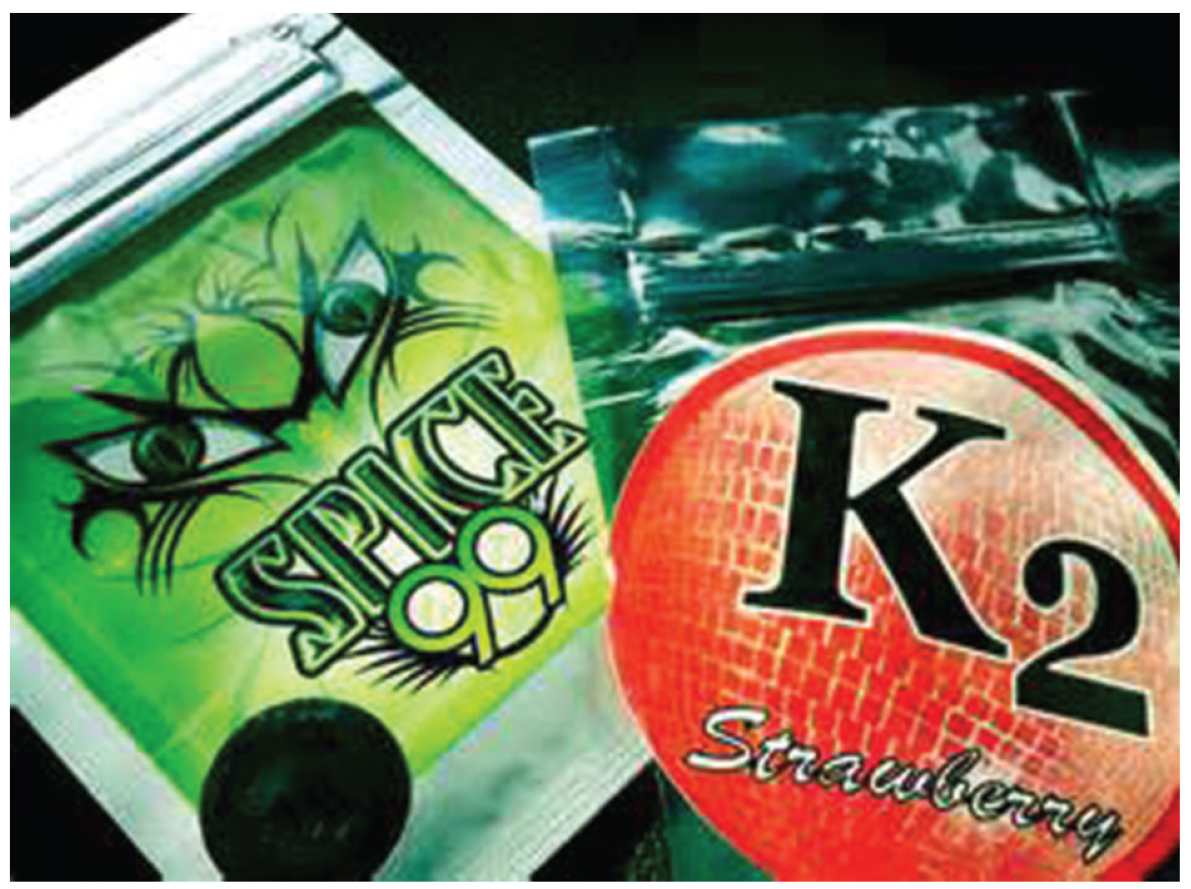Designer Drugs: Spice and Bath Salts
Guide I-110
Sonja Koukel
College of Agricultural, Consumer and Environmental Sciences, New Mexico State University
Author: Community and Environmental Health Specialist, Department of Extension Family and Consumer Sciences, New Mexico State University. (Print friendly PDF)
Introduction
To the uninitiated and uninformed, the names appear harmless enough: Spice, Bath Salts, K2, Moon Rocks, and Spice Diamond, among others (Figure 1). The labels might conjure up images of products found in retail bath and body shops. But that couldn’t be farther from the truth. These products are illegal designer drugs.
Spice is commonly known as synthetic cannabinoids or synthetic pot, and is meant to mimic the active chemicals found in marijuana (cannabinoids). The chemicals are sprayed onto herbs or other plant material. It is this herb/chemical mixture that is sold as Spice.
Bath salts (for instance, Bliss, Bloom, and Ivory Wave) contain synthetic cathinones (stimulants/hallucinogens) similar to amphetamines. Amphetamines stimulate the nervous system and have a medicinal role in a number of diseases (Newman, 2016). For example, amphetamines are used to treat attention-deficit hyperactivity disorder (ADHD). Bath salts are also referred to as jewelry cleaner, plant food, or phone screen cleaner.
Both bath salts and Spice are generally ingested through smoking. The chemicals are intended to create a high similar to smoking marijuana. However, ingesting these chemicals can result in emergency room visits or even death.
Poison Control Centers were among the first to sound the alarm about synthetic drugs (Cratty, 2012). Nationally, Poison Control Centers responded to 3,200 calls in 2010. But by 2011—just one year later—that number had jumped to 13,000 calls. Sixty percent of reported cases involved patients under 25 years of age (Cratty, 2012).

Figure 1. A sampling of synthetic drugs sold under different brand names. (Photo courtesy of Doña Ana County Sheriff’s office.)
Dangers of Designer Drugs
The situation is dire as designer drug use continues to climb among some age groups. Nationally, poison centers received close to 2,000 calls during 2015 (January 1–April 22) from people seeking help for adverse reactions from these drugs (see the Symptoms/Adverse Reactions section included in this document). This is almost four times the rate of calls received in 2014 (UNM, 2015). “In New Mexico, half of the 10 exposure calls [in 2015] for adverse reactions to these drugs have been made in the month of April, data that seems consistent with the national trend,” reported Jacqueline Kakos, New Mexico Poison and Drug Information Center Health Educator (UNM, 2015).
What makes designer drugs so dangerous is that these products are manufactured illegally, making them difficult to regulate. Most often, they contain unpredictable contaminants that do not show up in drug tests (Bush and Woodwell, 2014). “There is no consistency or quality control,” stated Barbara Carreno, U.S. Drug Enforcement Administration (DEA) spokesperson. “The people making these products can be anyone from a college kid wanting to make extra cash to an operation blending large quantities in a cement mixer. Two batches made by the same person could have different doses.” (Zdanowicz, 2013)
The year 2010 saw the first state laws banning Spice and bath salts. Currently, all 50 states have bans in place (NCSL, 2015). “The DEA has designated five of the most common active chemicals frequently found in synthetic marijuana as Schedule I controlled substances, making it illegal to sell, buy, or possess them. Manufacturers change the chemical compounds as fast as lawmakers enact legislation to ban them” (Wilson, 2013).
Targeted Audience
As previously stated, the majority of synthetic pot users are primarily youths under 25 years of age. In 2010, over 11,000 emergency room visits were linked to synthetic pot. Most affected were both males and females ages 12 to 29 (Mozes, 2012).
More specifically, for youths aged 12 to 17, synthetic pot use sent 3,780 youths to emergency rooms during 2010. In 2011, that number nearly doubled to 7,584. For patients aged 18 to 20, visits increased more than fourfold, from 1,881 to 8,212 between 2010 and 2011 (Bush and Woodwell, 2014). Recent reports find that one in every nine high school seniors admitted to having used synthetic marijuana (Monitoring the Future, 2011).
The problem is not only with those seeking a “legal high” but also with those in parole and probation situations and those in workplaces that require drug testing. This may be due to the ease of access of these products, and the inability to easily test for synthetic drugs using current clinical tests, parole and probation drug tests, and those routinely used in military and civilian workplace drug tests (Bush and Woodwell, 2014).
Marketing and Purchasing
There is no drug pusher or dealer required when looking for Spice or bath salts. In fact, the majority of sales occur through the internet (Wilson, 2013). Products are easy to find at convenience stores, gas stations, “head shops,” and other outlets. And unlike controlled substances such as tobacco and alcohol, there are no age restrictions for purchasing.
Marketing ploys are very misleading. Advertising the products using terms such as natural, organic, herbal incense, and potpourri are deceptive because the public perceives them to be safe. They are also advertised as a “legal” alternative to marijuana.
These products are often labeled as “potpourri” or “herbal incense,” and display “not for human consumption” labels. Distributors use these disclaimers to dodge the Controlled Substances Analogue Act, which covers any chemical similar to controlled substances (such as marijuana). With no warning labels, people without the wisdom or education about drugs can be misled and be unaware that using these products can be harmful or even deadly (SAMHSA NEWS, 2015; Wilson, 2013).
Symptoms/Adverse Reactions
Health effects from designer drug use can be life-threatening, and the onset of symptoms may be so sudden that there is no time to call for help. Symptoms and reactions may include:
-
Anxiety
-
Disorientation
-
Fast, racing heart rate and elevated blood pressure
-
Impaired perception
-
Intense hallucinations
-
Irritability
-
Muscle spasms, seizures, and tremors
-
Nausea and vomiting
-
Non-responsiveness, loss of consciousness, paralysis, and catatonic/listless states
-
Paranoid behavior and extreme paranoia
-
Psychotic episodes
-
Reduced motor control
-
Self-inflicted wounds
-
Severe agitation
-
Suicidal tendencies
-
Violent episodes and outbursts
-
Acute kidney injury
Toward Prevention
Designer drugs, such as Spice and bath salts, pose a serious threat to the nation’s public health and safety. At this time, very little is known about these drugs or how to treat an adverse reaction or overdose (Wilson, 2013).
Warning signs that someone you know may be using synthetic drugs include
-
bloodshot eyes,
-
migraine headaches,
-
mood changes, and
-
withdrawal.
For parents, effective interventions include discussing the dangers of these drugs with their children and using parental controls for online purchases (Cratty, 2012). The Partnership for Drug-Free Kids at Drugfree.org provides online tools to help adults understand synthetic drugs; visit https://www.drugfree.org/the-parent-toolkit/.
There are signs of hope for American youths. The University of Michigan’s Monitoring the Future Study (2015), an annual survey tracking teen drug abuse among 40,000 8th-, 10th-, and 12th-graders, shows some positive inroads and encouraging news in substance abuse among this age group. Findings were that use of several illicit drugs, including synthetic marijuana, showed a noted decline in the 2015 data. Parents, guardians, teachers, and other adults who work with youths are encouraged to be watchful in identifying the physical symptoms of individuals using designer drugs. It is imperative that everyone does their part to help minimize the damage of these illegal drugs.
References
Bush, D.M., and D.A. Woodwell. 2014, October 16. Update: Drug-related emergency department visits involving synthetic cannabinoids [Online]. The CBHSQ Report, Substance Abuse and Mental Health Services Administration. Retrieved from https://www.samhsa.gov/data/sites/default/files/SR-1378/SR-1378.pdf
Cratty, C. 2012, February. Online tools aimed at educating parents about synthetic drugs [Online]. CNN iReport. Retrieved from https://www.cnn.com/2012/02/16/health/synthetic-drugs/index.html
Monitoring the Future. 2015. Use of ecstasy, heroin, synthetic marijuana, alcohol, cigarettes declined among US teens in 2015 [Online]. Retrieved from https://monitoringthefuture.org//pressreleases/15drugpr_complete.pdf
Mozes, A. 2012, December. ‘Synthetic pot’ sending thousands of young people to ER [Online]. HealthDay. Retrieved from https://medicalxpress.com/news/2012-12-samhsa-er-synthetic-marijuana.html
NCSL (National Conference of State Legislatures). 2015, January 13. Synthetic drug threats [Online]. Retrieved from https://www.ncsl.org/research/civil-and-criminal-justice/synthetic-drug-threats.aspx
Newman, T. 2016, March. Amphetamine: Uses, side effects and contraindications [Online]. Retrieved from https://www.medicalnewstoday.com/articles/221211.php
SAMHSA NEWS. 2015, March 3. Not for human consumption: Spice and bath salts [Online]. Retrieved from http://newsletter.samhsa.gov/2015/03/03/not-for-human-consumption-spice-and-bath-salts/
UNM Health Sciences Center Newsbeat. 2015, April 30. Synthetic drugs re-emerging, warns poison control centers: New Mexico sees April increase [Online]. Retrieved from https://hscnews.unm.edu/in-brief/synthetic-drugs-re-emerging-warns-poison-control-centers
Wilson, J. 2013, September 7. 3 deaths may be tied to synthetic marijuana in Colorado [Online]. CNN. Retrieved from https://www.cnn.com/2013/09/06/health/synthetic-marijuana-denver
Zdanowicz, C. 2013, February 5. Teen narrowly escapes death after smoking synthetic marijuana [Online]. CNN iReport. Retrieved from https://www.cnn.com/2013/02/04/health/synthetic-marijuana-irpt/index.html
For Further Reading
I-104: Teens and Self-Cutting (Self-Harm): Information for Parentshttps://pubs.nmsu.edu/_i/I104/
I-107: Suicide Prevention and Intervention in Schools
https://pubs.nmsu.edu/_i/I107/
F-120: Creating Strong Families
https://pubs.nmsu.edu/_f/F-120/
F-122: Understanding Teens
https://pubs.nmsu.edu/_f/F-122/
All Health Publications Listing
https://pubs.nmsu.edu/_i/

Sonja Koukel is Assistant Professor and Extension Community and Environmental Health Specialist in the Department of Extension Family and Consumer Sciences. She earned her B.S. at NMSU and her M.S. and Ph.D. at Texas Tech University. Her Extension programs focus on health and wellness—physical, mental, spiritual, and environmental.
To find more resources for your business, home, or family, visit the College of Agriculture and Home Economics on the World Wide Web at pubs.nmsu.edu
Contents of publications may be freely reproduced for educational purposes. All other rights reserved. For permission to use publications for other purposes, contact pubs@nmsu.edu or the authors listed on the publication.
New Mexico State University is an equal opportunity/affirmative action employer and educator. NMSU and the U.S. Department of Agriculture cooperating.
June 2016


